In This Issue
The opinions, beliefs and viewpoints expressed in this publication are those of the authors. They do not necessarily reflect the opinions, beliefs, viewpoints or official policies of Autism Society Alberta.
|
|
|
End article-->
Update on ASA's Covid Response and Recovery Initiative
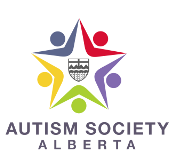
Last spring, a provincewide Autism Community Covid-19 Response and Recovery Initiative launched in partnership between Autism Alberta, Autism Calgary, Autism Edmonton, Autism Society of the Regional Municipality of Wood Buffalo, Peace Autism Society, Chinook Autism Society, and a network of individuals and families in Central Alberta.
For this twelve month initiative, Autism Society Alberta recruited a dedicated team of family support workers in Lethbridge, Grande Prairie, Fort McMurray and Central Region, plus three autistic peer mentors. Coordinating with the Autism Calgary and Autism Edmonton teams, this united autism community initiative connected with thousands of individuals and families from all over the province through wellness check-ins and virtual support groups. This work inspired town hall meetings, valuable discussions with province wide stakeholders, and plans are under way for future collaborative endeavors.
Although this specific Covid-19 Response and Recovery Initiative finishes on April 30th, we are pleased to continue to offer:
Contact information for the societies can be found here.
As we continue to navigate the pandemic, Autism Society Alberta remains committed to supporting the autism community during these difficult times in all ways possible.
|
|
|
Autism Alberta's New Sibling Toolkit


April 10th was Sibling Day, and to commemorate it, we launched our latest online toolkit: About Autism – A Sibling Toolkit.
Parents often wonder how to explain autism to a sibling. We hope that this toolkit and the resources it includes will help you guide the conversation and provide some useful information for the whole family.
Click here to see it
|
|
|
End article-->
Smoothing the Transition into High School
Kitty Parlby
Moving on to high school can be a big change for anyone, and perhaps even more so for some students on the spectrum. In many cases, they will be moving to a new (and sometimes much larger) building, often with bigger class sizes. Social expectations can be more complex. It could turn out that very few of their friends end up in the same classes with them. It’s just one big load of change! So I’m going to share some tips and ideas, for both educators and parents.
Parents should know that in some circumstances a student may stay in high school for more than the usual number of years, as my own son Eric did. However, this isn’t a given. Talk to the high school beforehand about their policy, as well as the school division’s policy. Once you do that, and all is good,  make sure you start preparing your teen for that possibility, keeping it light for now. That is preferable to it being a shock in Grade 12 that they may have to graduate a little later than the others. Also be aware that some students, like my son Eric, may finish high school with a certificate of completion instead of a diploma. If applicable, ask about what special needs programming or classes they offer. There’s a wide variety, with some programs (like life skills, etc.) being offered only in select schools in each school division. It may take some research to find a high school that is a good fit. make sure you start preparing your teen for that possibility, keeping it light for now. That is preferable to it being a shock in Grade 12 that they may have to graduate a little later than the others. Also be aware that some students, like my son Eric, may finish high school with a certificate of completion instead of a diploma. If applicable, ask about what special needs programming or classes they offer. There’s a wide variety, with some programs (like life skills, etc.) being offered only in select schools in each school division. It may take some research to find a high school that is a good fit.
Ideally, for special needs students who need support, there should be a transition meeting in May or June before high school. Those attending should include the staff who know the student best, the parents, and possibly specialists that worked with the student, if needed. You can also include other personnel from the high school, especially anyone involved with special needs planning for the new school. If appropriate, the student themselves can attend for part or all of the meeting, or have a list of their questions and preferences ready ahead of time.
Here are some considerations when planning:
- Safety: High school students can leave school without being noticed – How can this be handled? What to do if bullying occurs? Who do they go to if help is needed? Where are some safe and/or calming spaces? etc.
- Is there support if your student struggles with executive functioning (organizing, prioritizing, scheduling, etc.)?
- Is a full course load too much? What are the options?
- If needed, will your student have an Educational Assistant?
- How will transitions within the school day be supported? (Between classes, lunch, bussing, etc.)
- What specialists are available to support challenges like sensory issues, communication, social skills, and anxiety?
- Ask the student for ideas on what might help them during this transition.
Let’s get into some strategies on how to make the transition successful. Pick out the tips that are appropriate for your student. Who knows where we’ll be with Covid restrictions when your teen is about to transition; some of these ideas may or may not be permitted by then.
- Go online and find a floor plan/map of the school with the room numbers on it. Map out routes to classes and other areas of interest or support. Check out the school’s photo gallery to get familiar with how it looks. Learn about the sports teams, the school mascot, and special interest clubs.
- If there are staff photos online, look for the people who will be part of their school life. You can even print out some of the pictures with their names typed under them to help your student become familiar with those staff; they can even look at the photos throughout the summer. This is especially important for those working closely with them, such as Educational Assistants. Note: If there are no photos on the website, ask the school for pictures of key people and let them know why.
- Visit the school at least once before classes start. You’ll have to arrange this with the school. Walk the halls in the same order as the student’s class schedule, maybe meet some of the teachers, and visit popular areas like the library, gym and cafeteria. Pack a lunch or snack and eat it where they might usually eat lunch. Perhaps visit the special needs coordinator at their office, so their location is known. Visit any safe spaces, and the sensory room, if they have one.
- Pair the student up with a peer or two to help them navigate the physical space, learn the expectations, meet new people, and to alleviate a feeling of isolation in the crowd.
 If appropriate, educate any staff who will be working with the student about their particular challenges and strengths, including ideas on how to support them. If possible, talk to the student about which peers they are comfortable disclosing their autism diagnosis to. If appropriate, educate any staff who will be working with the student about their particular challenges and strengths, including ideas on how to support them. If possible, talk to the student about which peers they are comfortable disclosing their autism diagnosis to.
It is common for transitions to be challenging and anxiety-provoking for those on the autism spectrum. With some foresight, planning, and input from the individuals themselves, we can help make their start into this new phase a positive one!
Kitty Parlby is the mother of a young adult with autism. She is a former special needs Educational Assistant and an autism speaker and consultant with Autism Inspirations. She currently works as a Family Support Worker for Autism Society Alberta.
|
|
|
Poverty Reduction Table – AISH Educational and Awareness Campaign
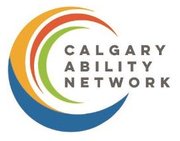
Goal:
We are looking for people’s experiences as AISH recipients as they relate to finances, basic needs, participation in recreation and in the community, transportation, and medical coverage. The aim is to include AISH recipients from various background, including members of racially marginalized groups and AISH recipients living with their families.
Question:
How does AISH impact your life?
Format:
A written story, maximum 250 words or ½ standard Word page, single-spaced.
Deadline:
May 18th , 2021 by 4:30 pm. Please submit the story to ermira@cpalberta.com
|
|
|
End article-->
It Has Been A Pleasure!
Brandon Rudics
May of 2020 was certainly a wild time in our province. Covid had reared its ugly head. Lockdowns and quarantines commenced. Schools had closed a few months prior. The province, and our amazing autism community, was in chaos.
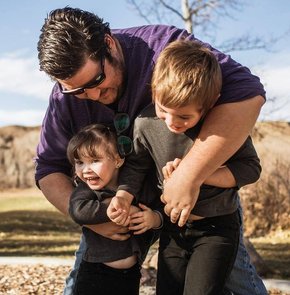 Then a great opportunity arose within Autism Society Alberta. An opportunity for myself to work from home during the pandemic, while also helping families in my region as much as possible. I jumped at this opportunity, and am forever grateful I did! Then a great opportunity arose within Autism Society Alberta. An opportunity for myself to work from home during the pandemic, while also helping families in my region as much as possible. I jumped at this opportunity, and am forever grateful I did!
As part of our Covid-19 response team, I am proud to say that, to date, I have been in contact with and helped over three hundred families. I have laughed and cried with Autistic individuals, parents and caregivers, and allies alike. I have learned so much more than I could have imagined from this position.
During my time with this great organization, I was also able to help create an LGBTQ+ online support group for Autistic adults. There was a huge need for this group, not only in our province, but in the entire country. This group has been going strong since December, growing every single month, and has even had members join from Ontario.
This article may sound like a goodbye, but let me clear the air. Although this Covid response program grant is done at the end of this month, I am hopeful that the amazing collaboration with our autism groups will continue. I will not be leaving completely. My wife and I, along with other volunteers, will continue advocating and helping families in the southern Alberta region with Chinook Autism Society. I will still be attending our various online support groups, including the LGBTQ+ and the Dads support group. I am still available for you!
 All in all, I want to thank all our colleagues, and everyone involved in our amazing provincial Autism alliance. I also want to thank the families and autistic individuals who I have helped, and also learned so much from. All in all, I want to thank all our colleagues, and everyone involved in our amazing provincial Autism alliance. I also want to thank the families and autistic individuals who I have helped, and also learned so much from.
Remember my first article? Change is constant. There will always be change. So instead of being scared of change, embrace it! Life is easier that way. I look forward to what the future holds for myself and my family. Thank you all!
|
|
|
Canadian Journal of Autism Equity

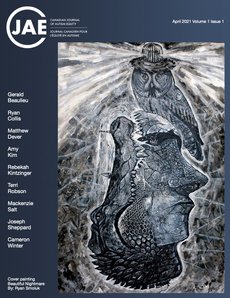 Established in 2021, the Canadian Journal of Autism Equity is an open-access e-journal focused on critically engaging with a variety of equity discussions within the autism community and public policy. Seeking authorship primarily by first-voice Autistic people or people with lived experience with autism and intersectionality, the Journal seeks to offer a platform to amplify marginalized voices and share these perspectives with decision-makers and Canadians alike. Established in 2021, the Canadian Journal of Autism Equity is an open-access e-journal focused on critically engaging with a variety of equity discussions within the autism community and public policy. Seeking authorship primarily by first-voice Autistic people or people with lived experience with autism and intersectionality, the Journal seeks to offer a platform to amplify marginalized voices and share these perspectives with decision-makers and Canadians alike.
CJAE will be published twice each year, once in April following World Autism Acceptance Day and once again in October marking Canadian Autism Acceptance Month.
Click here to read the first issue
|
|
|
Estate Planning Series: Part 2 – Inter Vivos Discretionary Trusts (Henson Trusts)
Nicole Wiebe
Last month, in Part 1 of this series, we discussed Henson Trusts and the ability to set up a Henson Trust as a Testamentary Trust in a Will. In Part 2 of this series, we are going to discuss Henson Trusts as an Inter Vivos Trust, while also discussing some of the requirements in setting up a Henson Trust, and some key issues and questions that should be addressed in the trust document.
Unlike a Testamentary Trust, which only comes into effect after a testator dies, an Inter Vivos Henson Trust is a trust document which you can set up and place property in now, and going forward, for the benefit of an AISH recipient to further protect their AISH entitlement and provide a long-term fund for them.
As discussed in Part 1, for an applicant to qualify for AISH, his or her financial assets cannot exceed $100,000. There are some exempted assets, such as, but not limited to, a house, locked-in retirement accounts, or a Registered Disability Savings Plan. With the recent changes to the AISH legislation, a person's interest in a qualifying discretionary trust (also known as a “Henson Trust”) is now also explicitly excluded from the calculation of an applicant's assets. This exemption also includes Inter Vivos Henson Trusts.
 A trust is, in essence, a relationship between the trustee, who holds the property, and the beneficiaries, who benefit from the property, but who don't get to hold it. The trustee must hold, protect and use the trust property for the sole benefit of the beneficiaries, but how exactly the trustee does that is up to him or her. The beneficiaries have no authority to demand that they receive property. A trust is, in essence, a relationship between the trustee, who holds the property, and the beneficiaries, who benefit from the property, but who don't get to hold it. The trustee must hold, protect and use the trust property for the sole benefit of the beneficiaries, but how exactly the trustee does that is up to him or her. The beneficiaries have no authority to demand that they receive property.
With an Inter Vivos Henson Trust, funds will be held in trust for the disabled beneficiary, and used for the beneficiary, as determined solely at the discretion of the trustee of the trust. The beneficiary has no say in how the income or capital of the trust are used, and therefore the assets in the trust are not included in the beneficiary’s net worth, nor are the funds vulnerable to claimants or creditors of the beneficiary.
In setting up a Henson Trust, whether by way of a Testamentary Trust or an Inter Vivos Trust, you should consider these issues and questions, and address them in the trust document:
-
Who will be the trustee or trustees, and the alternate trustee or trustees?
-
Does the trustee get compensation for managing the trust? If so, how will compensation be determined?
-
Who should the trustee account to, and how often?
-
What are your wishes for how much income and/or capital the trustee can use for the beneficiary of the trust? It is important to provide guidelines – for example, on whether to use their own resources first, or use government resources first; whether to allow a certain sum, or the entirety of the Trust, to be used to purchase a home or vehicle; etc.
-
Who will the beneficiaries of the trust be after the disabled beneficiary has passed away?
-
For tax purposes, if the beneficiary qualifies for the Disability Tax Credit, he or she can have one Testamentary Trust set up for him or her that is taxed at graduated rates, instead of at the top marginal rate. This tax-preferred trust is called a Qualifying Disability Trust (QDT), so you need to actively consider which trust would benefit most from this designation, and make the proper elections.
It is also important to note that any income generated and received by the AISH recipient from the funds in the trust will be considered as part of the AISH recipient’s income as per the AISH legislation. It will be included when determining eligibility for AISH and the amount of monthly funding one receives.
The is also a one-year period within which assets that have otherwise been received – for example, by way of a gift, or settlement, etc. – can be invested into an Inter Vivos Henson Trust without affecting an individual’s eligibility for AISH.
 With regard to Henson Trusts in general, there has been a bit of misinformation and concern in the community regarding the inability to use Henson Trusts as a way to ensure that an AISH recipient’s assets in the trust do not disqualify them from AISH entitlement. The Assured Income for the Severely Handicapped General Regulation, the legislation which governs AISH eligibility and requirements, explicitly states in Schedule 2, “Determination of Value of Assets”, that an asset held in a trust, and one in which the applicant has a beneficial interest, is not included in a determination of assets. Below are some useful links to government websites which include additional information regarding the use of Henson Trusts and AISH eligibility: With regard to Henson Trusts in general, there has been a bit of misinformation and concern in the community regarding the inability to use Henson Trusts as a way to ensure that an AISH recipient’s assets in the trust do not disqualify them from AISH entitlement. The Assured Income for the Severely Handicapped General Regulation, the legislation which governs AISH eligibility and requirements, explicitly states in Schedule 2, “Determination of Value of Assets”, that an asset held in a trust, and one in which the applicant has a beneficial interest, is not included in a determination of assets. Below are some useful links to government websites which include additional information regarding the use of Henson Trusts and AISH eligibility:
If you are deciding to set up an Inter Vivos Trust for yourself or for your loved one, it is important that you seek out legal advice so that the trust is set up properly, as certain provisions and directions need to be included in order to properly protect AISH entitlement.
Part Three of this estate planning series will discuss supported decision-making documents. Supported decision-making documents are documents that allow people with disabilities to retain their decision-making capacity by choosing supporters to help them make certain decisions regarding health care and other personal matters.
Nicole Wiebe
Associate, Trusts, Estate, and Wealth Preservation Group at Dentons Canada LLP
For further information regarding the information contained in this article, you can reach Nicole at nicole.wiebe@dentons.com.
|
|
|
Spectrum Siblings
Karla Power
April is Autism awareness month, and this year I want to challenge everyone to move past awareness and towards acceptance. For the past three years, I have been sharing information about Autism with our friends, family and colleagues. Now that we have two children on the spectrum, it’s time for us to teach acceptance.
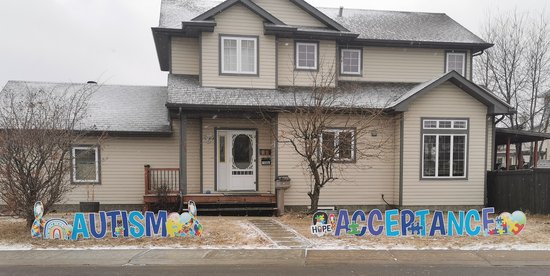
Our boys are who they are, and Autism is part of who they are, but definitely does not define them. They both teach us new things everyday, and the most important thing that they are teaching us is acceptance. Recently, I have begun taking videos of them being their true selves. My plan is to share these videos throughout the month of April so that people have a better understanding of what our life is actually like.
 Some videos, like the one of the boys swinging joyfully together, will make you smile. Others, like the four minute video of us struggling to cut Paddy’s nails, will hurt your heart. Showing people what our life is like will not always be pleasant, but that is our reality and a step towards acceptance. Some videos, like the one of the boys swinging joyfully together, will make you smile. Others, like the four minute video of us struggling to cut Paddy’s nails, will hurt your heart. Showing people what our life is like will not always be pleasant, but that is our reality and a step towards acceptance.
The other thing that these videos will show is how different each of the boys are! They truly are siblings of the spectrum. Kelton is a social butterfly who enjoys when – or actually, demands that others play with him. On the other hand, Paddy would prefer to play alone, but sometimes pays attention and shows affection to us. These moments are very special ones, since they are few and far between.
Each of the boys has their own strengths. Paddy is very physical and flexible. He enjoys climbing, jumping and being on the move. It is so cute to watch his younger and less agile brother try to keep up. Kelton is really into toys lately, and loves putting puzzles together! Some days I feel like they couldn’t be any more different, and then I remind myself that it is called a spectrum for a reason.
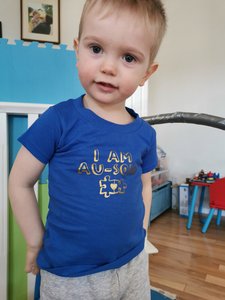 Other days, the boys are more alike. They both love music and car rides. Their diets are very similar, as are some of the other challenges they face. They both are currently classified as non-verbal, although we feel that they will both learn to communicate in their own ways. They also both require 1:1 assistance with most things. On the flip side, they are both very loving and kind. They do not care what others think about them, which must be so freeing! Other days, the boys are more alike. They both love music and car rides. Their diets are very similar, as are some of the other challenges they face. They both are currently classified as non-verbal, although we feel that they will both learn to communicate in their own ways. They also both require 1:1 assistance with most things. On the flip side, they are both very loving and kind. They do not care what others think about them, which must be so freeing!
These siblings cover a wide range of the spectrum, and life is certainly never dull raising them. My hope is that they will grow up to be exactly who they were meant to be, letting their true colours shine. I certainly hope the world is ready for them and their many colours.
Click here to visit our YouTube channel
|
|
|
Research Study Looking for Peer Facilitators

Digital storytelling: An intervention model for inclusion and capacity building among youth with developmental disabilities
Would you like to take part in a research study?
We are looking for youth:
- Who self-identify as a person with a developmental disability
- Who are between 18 and 30 years of age
- Who are enrolled in a full or part-time post-secondary program
to take part in a facilitator training workshop where they will complete a digital story about their experiences transitioning into post-secondary, work, and/or community living. Digital storytelling combines the tradition of oral storytelling with photography to create a short video about a personal experience. No previous technical skills are needed.
 You would be involved in a six-day online digital storytelling training workshop. Once you complete the workshop, you have the opportunity to assist in facilitating future workshops for other youth with developmental disabilities in 2021. Timing for future workshops depends on enrollment. You would be involved in a six-day online digital storytelling training workshop. Once you complete the workshop, you have the opportunity to assist in facilitating future workshops for other youth with developmental disabilities in 2021. Timing for future workshops depends on enrollment.
Facilitators will receive $250 honourarium for every workshop they facilitate.
For more information on this study, please contact:
Kathleen Sitter, PhD
Faculty of Social Work, University of Calgary
youthdigitalstories@gmail.com or 403-220-4573
|
|
|
Modeling: Part 3
Carmen Moore
This month, I plan to continue to highlight the EBP of modeling. This is the third, and final, part of a series, so if you haven’t read them already, feel free to look back at Part 1 and Part 2. In a nutshell, modeling is simply the act of intentionally showing a learner what we would like them to know or do in a systematic way. As usual, modeling can be used in conjunction with other EBPs that we have highlighted in the past, as one piece of a larger puzzle.
There are three prerequisites before you can decide if modeling would be an appropriate strategy to use with a learner. The learner must be able to:
- Imitate others’ behaviours
- Have some of the skills necessary to complete the task or reach the intended goal
- Sustain attention long enough to watch the model
One important thing to note about this strategy is that it will only have a chance at being effective if the individual has the ability to actually imitate or copy the behaviour of others. This is not always automatic when someone is on the spectrum. I remember when one of our home therapists encouraged me to regularly play ‘copy me’ when my child was a toddler to encourage that skill. At the time, I didn’t realize the implications and importance of developing the ‘copy me’ skill, but can now see how often it is needed to make gains. If your child or student has yet to develop that particular skill, find fun and intentional ways to build the practice of the skill into your daily routine. For example, copy funny faces and make it joyful, or play a few minutes of ‘do this’: do one action and have the learner repeat it immediately afterwards, or say a funny word and the learner copies, etc. It doesn’t have to be boring or a drill to encourage this necessary skill.
Research tells us that the learner needs to have some existing ability to do at least some parts of the new skill. Some elements of the skill may be teachable, but having to learn every part as a new skill from scratch will not lend itself to successful modeling. For  example, if you have the goal of independently making an order at a coffee shop, the learner should know how to use a bank card or tap a credit card, and be able to engage somewhat with a stranger. Some of the skills can be taught beforehand. A script of the whole exchange can be used to help prepare for the task. The learner would watch the person modeling from start to finish, and then try pieces or the whole thing on their own. This will let them know what it should look like in general, which makes tasks – especially new ones – less stressful. example, if you have the goal of independently making an order at a coffee shop, the learner should know how to use a bank card or tap a credit card, and be able to engage somewhat with a stranger. Some of the skills can be taught beforehand. A script of the whole exchange can be used to help prepare for the task. The learner would watch the person modeling from start to finish, and then try pieces or the whole thing on their own. This will let them know what it should look like in general, which makes tasks – especially new ones – less stressful.
The learner’s attention span is also an important factor. If the learner only has a few seconds of attention span (for whatever reason), the strategy of modeling would not be appropriate unless the task were only a few seconds long. Try to make the showing of the skill as simple and concise as possible, as sustained attention is key for this strategy to be successful. This can vary greatly from learner to learner. When ADHD or ADD is a comorbid diagnosis, this aspect can be more challenging. If it is possible, but there need to be extra or external reinforcers to ensure they are watching the model, do not be afraid to offer them. For example, if the learner may be able to watch longer with a promise of a reinforcement, go for it. If a piece of gum will get them to observe the model longer, great!
Lastly, use modeling as a primer or a prompt. That simply means to use it at the very beginning of a new skill to show the learner what the final outcome is to look or sound like, or to use modeling in the middle of teaching the skill if they have forgotten all or part of it. For example, if you want the learner to learn to remember to lock up at night, show them all of the steps at the beginning of the learning process: lock the doors, ensure the  stove is off, turn off the lights, turn down the heat, etc. At this point, they simply observe. When you use modeling as a prompt, the learner can usually do it independently, or can do most of it independently after being taught/practiced. If they forget how to one or more of the steps, you can model the missing part of the process for them again. stove is off, turn off the lights, turn down the heat, etc. At this point, they simply observe. When you use modeling as a prompt, the learner can usually do it independently, or can do most of it independently after being taught/practiced. If they forget how to one or more of the steps, you can model the missing part of the process for them again.
This wraps up my mini-series on modeling. I hope that you have found it helpful, and that it has added one more evidence-based practice to your toolkit for positively supporting someone with autism. However, I do believe this strategy, in particular, is one that is ‘good for all, critical for some’. The popularity of ‘how-to’ you tube videos lends itself to the effectiveness, as well. Video modeling is actually counted as a separate EBP, but it is definitely related. With its focus on visuals, it can be especially helpful for learners with any sort of language delay.
If you are interested in checking out the free online AFIRM modules, click here to view the Modeling module, and click here to view the entire series.
|
|
|
Share Your Experiences with Autism
 The Canadian Academy of Health Sciences was selected by the Canadian government to conduct an assessment on autism. It will consider scientific information and also be informed by a public engagement process. The assessment will be used by policy makers as they consider the development of a National Autism Strategy. The Canadian Academy of Health Sciences was selected by the Canadian government to conduct an assessment on autism. It will consider scientific information and also be informed by a public engagement process. The assessment will be used by policy makers as they consider the development of a National Autism Strategy.
An important part of this assessment is input from Autistic people, family members, and others who support them, including service providers, educators, volunteers and organizations.
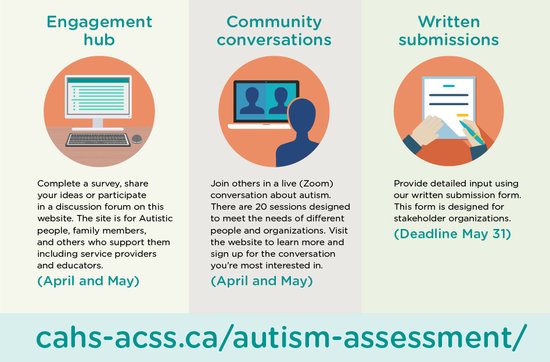
Click here to learn more
|
|
|
Caregivers and Increased Demands During the Pandemic
Maureen Bennie

From the Autism Awareness Centre Inc. Blog:
The pandemic has changed many aspects of our lives. Caregivers have had increasing demands and responsibilities placed on them because of lockdowns, program cancellations, difficulty retaining staff, illness and quarantines, new protocols and school closures. Community organizations have closed their doors to in-person meetings and have switched to online and phone support for their clients and members. Increased isolation has made caregivers feel alone and isolated without access their support systems such as family members and friends.
 We are now at the one year mark since the pandemic began, and many caregivers are feeling burned out. There will more than likely be another year of restrictions in place until the vaccination program is well established. We are now at the one year mark since the pandemic began, and many caregivers are feeling burned out. There will more than likely be another year of restrictions in place until the vaccination program is well established.
In January, the Globe and Mail published an interesting article on the extra pressure caregivers are now facing. They said:
It’s estimated that the labour provided by family caregivers accounts for roughly 75 per cent of all patient care in Canada, saving taxpayers between $24 billion and $30 billion in health care costs a year. More than eight million Canadians are caregivers – and nearly half of us will become one at some point in our lives.
Aside from any burdens they may share, the one thing advocates say virtually all caregivers have in common is feeling invisible. Many caregivers and advocates the Globe spoke with say they don’t feel supported or respected by the health care system – and that their work caring for others goes largely unacknowledged.
In October 2020, The University of Alberta released a report entitled A Tale of Two Solitudes Experienced by Alberta Family Caregivers during the COVID-19 Pandemic. The data in this report gives an accurate picture of what caregivers have been facing during this unprecedented time. I took part in this caregiver survey to bring representation of what life is like caring for two adults on the spectrum who have lost every community opportunity that they had for a life outside of our home, and the pressure my husband and I feel trying to work from home and provide their care with very few breaks, 7 days a week.
While this survey gathered data from families in Alberta, it would describe an accurate picture of caregiver demands in many communities.
Highlights from A Tale of Two Solitudes
Over half of the caregivers completing the survey reported at least one or more of these symptoms of stress since the start of the COVID-19 pandemic:
 57% of family caregivers agreed that they have “not been able to take a break”. 57% of family caregivers agreed that they have “not been able to take a break”.- 68% of family caregivers agreed that they were always “thinking about all care tasks they had to do”.
- 79% of family caregivers agreed that they have been “feeling more frustrated”.
- 62% of family caregivers stated that they were “not sleeping well”.
Anxiety is the most frequently occurring psychological disorder among family caregivers. Typically, family caregiver anxiety rises as care responsibilities increase and energy levels are depleted.
- 78% of family caregivers reported anxiety.
- 85% of family caregivers reported loneliness.
Family caregivers’ health deteriorated. Higher intensity care (care overload/ worry) has a negative impact on the caregiver’s health. Since the outbreak of COVID-19:
- 58% of family caregivers noted a deterioration in their mental health.
- 48% of family caregivers noted a deterioration in their physical health
Read more (Click the link and scroll down to "Recognizing When A Caregiver Needs Support for Their Health")
|
|
|
Webinar: How to Incorporate Structured Strategies into Everyday Life

Thursday, May 6, 2021 – 10 am-11 am (Mountain Time)
Featuring Amy Gaffney
 Strategies that provide structure and predictability help individuals on the spectrum better understand a given situation, which leads to greater success and independence. Strategies that provide structure and predictability help individuals on the spectrum better understand a given situation, which leads to greater success and independence.
This webinar will discuss three structured strategies that can be used throughout a person’s day: structured language supports, visual schedules, and work systems. These strategies are often introduced at school, but should also be extended into a child’s home and community, and continue to be utilized into adulthood. Participants will have the opportunity to make an action plan as they learn more ways to utilize structured strategies throughout the day.
Click here for the agenda, presenter bio, and to register
|
|
|
Upcoming Caregiver Workshops

Caring for the Caregiver: Acceptance and Commitment Therapy 5 Session Workshop
 May 5, 12, 26 and June 2, 2021 May 5, 12, 26 and June 2, 2021
12:30 pm - 2:30 pm
These sessions will be delivered for FREE online via Zoom.
Click here to learn more and to register
Acceptance and Commitment Therapy for Caregivers – What’s It All About?
 May 13, 2021 May 13, 2021
6:30 pm - 8:00 pm
This workshop will be made available for FREE online via CES Webinar.
Click here to learn more and to register
|
|
|
Workshops from the Centre for Autism Services Alberta
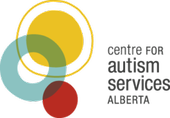
Menstruation Workshop (Online)
May 3, 6-8 p.m.

Getting your period can be a confusing and challenging time for autistic youth, so preparing for this change is vital. This workshop will cover strategies, tips and tools to make it less daunting.
The menstruation workshop will discuss:
- Tools and strategies to start preparing for changes associated with menstruation
- Where to begin teaching skills needed to manage menstruation and menstruation products
- Possible challenges and common questions associated with menstruation
Live Q&A throughout.
Register today for FREE!
Onsite Early Childhood Services (PUF)
Limited Spots Left for September!

NOW ACCEPTING APPLICATIONS for our Centre-based PUF program for kindergarten and preschool! The Centre's Edmonton office offers an onsite program for children aged 2 years 8 months to 5 years 11 months (as of Sept. 1).
What's included with Onsite PUF Programming?
- Four hours of learning per day, five days a week
- Certified teachers
- Highly trained educational assistants
- Weekly support from SLP, OT and Behaviour Specialists
- Coordinated support: if your child is receiving Specialized Services at the Centre, we will coordinate your services and PUF program through your Centre team, simplifying communication and ensuring consistency.
Spaces are filling quickly for September, so apply today!
|
|
|
|
|